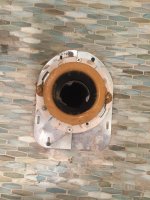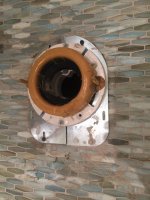The old toilet flange ripped off my 4" drain pipe.
I was considering installing an Oatey PVC slide in compression flange but don't have a way to secure it (see photo). I filled the gap surrounding the flange with spray foam to form a base - the gap down to the foam is about 1-1/2" to 2" deep. (This is in between floors - so needed a way to hold up from dropping down to the ceiling slab of the next floor.) I planned to fill the rest with concrete.
I was thinking anchoring concrete but the pipe feels a little soft? Maybe that's just the old lead remnants near the top from the last flange? But I'm concerned that because anchoring concrete expands (per the spec sheet) that it might deform the shape of the pipe. Maybe it would be better using hydraulic cement? Or is there a better suggestion entirely?
 Thanks for any help.
Thanks for any help.
I was considering installing an Oatey PVC slide in compression flange but don't have a way to secure it (see photo). I filled the gap surrounding the flange with spray foam to form a base - the gap down to the foam is about 1-1/2" to 2" deep. (This is in between floors - so needed a way to hold up from dropping down to the ceiling slab of the next floor.) I planned to fill the rest with concrete.
I was thinking anchoring concrete but the pipe feels a little soft? Maybe that's just the old lead remnants near the top from the last flange? But I'm concerned that because anchoring concrete expands (per the spec sheet) that it might deform the shape of the pipe. Maybe it would be better using hydraulic cement? Or is there a better suggestion entirely?




